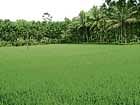DK's dying paddy culture

This is the gloomy situation of paddy cultivation in coastal Karnataka. Once home to paddy fields, coastal Karnataka is facing a deep crisis today. The days seem to be long gone when a farmer would grow enough paddy in spite of all odds and feel proud of it. The area under paddy cultivation in the country in 1999 was 45 million hectares, it came down to 42 million hectares in 2005. In Dakshina Kannada district, the area under paddy in 1995-96 was 49 per cent of the total cropping area which came down to 36.5 per cent by 2004. Wellknown agriculturist Chandrashekar Yethadka explains, “If the same situation persists, people may have to stand in front of grocery shops in long queues to buy rice. Imagine the condition of the poor and the needy, then.”
Paddy cultivation in the country is not merely restricted to agriculture; it is a culture by itself. The paddy fields, cow sheds and the kitchen form a strong chain in our life. It is no longer so now. In the Dakshina Kannada district of the Eighties, thanks to shooting prices of areca, many of the paddy fields were converted into areca farms. Unlike areca, paddy demands strict and timely farm operations, high manpower and is more prone to the vagaries of nature. Labour problems have also been severe.
Senior paddy farmer K S Kamat feels even the new improved varieties which were released could not adapt well to the odd conditions and created a feeling that paddy cultivation was not economic.
Farmers in the region are opting for alternate vegetable crops as they fetch better returns.
Commercial crops like stevia, vanilla and rubber rule. With paddy cultivation taking a backseat, much of the traditional knowledge of cultivation and seed storage is vanishing.
Mudi, a traditional storage container made out of paddy straw used to be an excellent device for storing rice and paddy for years.
A ray of hope
Even though the sources of local paddy varieties are fast disappearing and the scene is gloomy, people like Amai Devaray of Belthangady (conserves around 60 paddy varieties), Anand Bangera of Karvashe (has 40 varieties), organic farmer Lingamaadayya of Channapattana, Shankar guru of Narasingapura, Nandish of Charchigundi, Boregowda of Shivalli, Anjaneya of Kambaloor have come up successful against all such odds. Apart from the efforts to conserve the local seeds, it is also essential that paddy cultivation be given the form of a movement and re-energised.
For a country like India where food security is already a problem, moving away from paddy cultivation can be a severe blow and detrimental. Amai Devaray of Belthangady has as many as 60 varieties of paddy. Some of them are Allyande, Kavlakannu, Hallinga, Kolakedodra, Moradda, Maskati, Ajasapale, Kundapullan, Adenakelte, Mysore mallige, Bilinellu, Kariyajebi, Ubaramunda, raskadam, Ratnachoodi, Chare, Nagabatta, Kanva, Kaamadhari, Kumeru, Ajjge etc. In Malnad (rainfed region) they have varieties like Siddasaale, Rajabhoga, Parimalasaale, Jeerigesaale, Jolaga, Karekaaldadiga, Sannavaalya, Pattahagge, Nereguli, Jeddubhatta, Nyareminda, Doddibhatta, Saalubhatta, Anekobibhatta, Kenpu mundaga, Maroodi, Jenugoodu etc.
Deccan Herald is on WhatsApp Channels| Join now for Breaking News & Editor's Picks